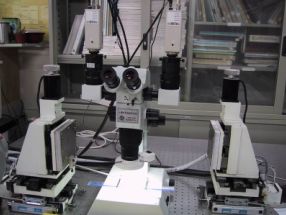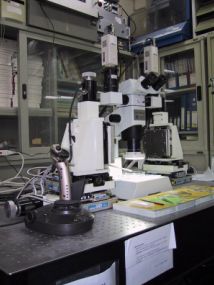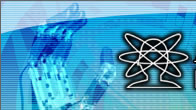 |
In recent years, with the rapid development of micro and nanotechnology attracting global attention, our laboratory has gradually shifted its research focus to the dynamic behavior in the microscopic world. The main research topics can be roughly divided into two parts:
- Micro-Nano Manipulation and Processing Technology
- System-on-Chip Design and Development
Micro-Nano Manipulation and Processing Technology:
In the field of micro-nano manipulation and processing, our laboratory is currently developing an automated precision assembly system. By using a binocular vision method, we estimate the depth information of objects, and then the central control computer calculates obstacle avoidance and the optimal movement path. Control signals are then sent to a piezoelectric-driven precision motion platform to manipulate micro-particles. In the future, we also plan to develop micro-grippers and micro-injectors for injecting and manipulating biological cells.
In terms of nano-processing, we utilize the popular scanning probe microscope (SPM) for micro-etching, manipulating micro-particles to form specific text, or etching microelectronic components on silicon substrates. These are the main directions of future applications.
System-on-Chip Design and Development:
In the field of System-on-Chip (SoC), advances in manufacturing technology have enabled continuous progress in the global IC industry, following Moore��s Law. While chips in the past could only perform a single function, today's trend has shifted towards integrating multiple chip functions into a single System-on-a-Chip (SoC), leading to the development of lighter, thinner, shorter, and smaller system products.
We have established a complete SoC development environment, covering system simulation, software-hardware co-simulation, circuit analysis simulation, design, and layout. Our focus is on the development and integration of silicon intellectual property (SIP), SoC chips, and microelectromechanical systems (MEMS) for various applications. For example, the SoC design process will be applied to the development of integrated multifunctional intelligent prosthetics. This will enable the manufacturing and integration of embedded tactile sensors, electromyographic (EMG) signal recognition modules, and control modules into a microcontroller system, aiming for a compact, portable, and high-speed processing solution.
|
Automated Precision Assembly System Project Overview
In recent years, with the development of nanotechnology, attention has gradually shifted from the macroscopic world to the microscopic world. The dynamics of the microscopic world can no longer be analyzed solely using traditional dynamics, as the primary forces acting at this scale are not as easily observed and analyzed as in the macroscopic world. Additionally, the complex interactions between particles make analysis even more challenging. Due to these difficulties, controlling micro-particles becomes even harder. Issues such as the methods and forces used to grasp particles, the effects encountered during movement, and the techniques for placing particles all present significant challenges in microscopic operations.
The "Automated Precision Assembly System" proposed in this project aims to further understand and explore the microscopic world. The main function of this system is to manipulate micro-objects (such as biological cells), including imaging, path planning, and control operations. As this involves multiple technical fields, the project is mainly divided into the following three major components:
- Stereoscopic Imaging: Development of a stereoscopic imaging system.
- Path Planning: Development of a path planning algorithm.
- Precision Positioning: Development of a precision micro-motion platform positioning system.
The "Automated Precision Assembly System" can be applied to various fields, including biology, medicine, and engineering. By utilizing the stereoscopic imaging system, we can obtain image information of micro-objects. Based on this information, the robotic arm's path can be planned, and the micro-motion platform can be used to ensure that micro-objects successfully navigate around obstacles and reach their designated targets.

Figure 1: Automated Precision Assembly Platform.

Figure 2: Automated Precision Assembly Platform and Control Unit.
|
A dexterous artificial prosthetic limb should have the following functions and appearance:
- Able to measure surface electromyography (EMG) signals from the muscles of an amputee and accurately recognize the EMG signals to generate the correct gripping motion.
- The acquired EMG signals must be meaningful.
- Capable of dexterous operation.
- Must have a suitable training environment.
- Able to precisely detect force, and additionally, tactile sensors should be embedded within the prosthetic limb.
- The EMG recognition module and prosthetic hand control module should ideally be portable.
The goal of these six objectives is to develop an intelligent, portable, and human-like artificial prosthetic limb that can be practically used by amputees.

Figure 3: Illustration of Artificial Prosthetic Limb Operation.
|













